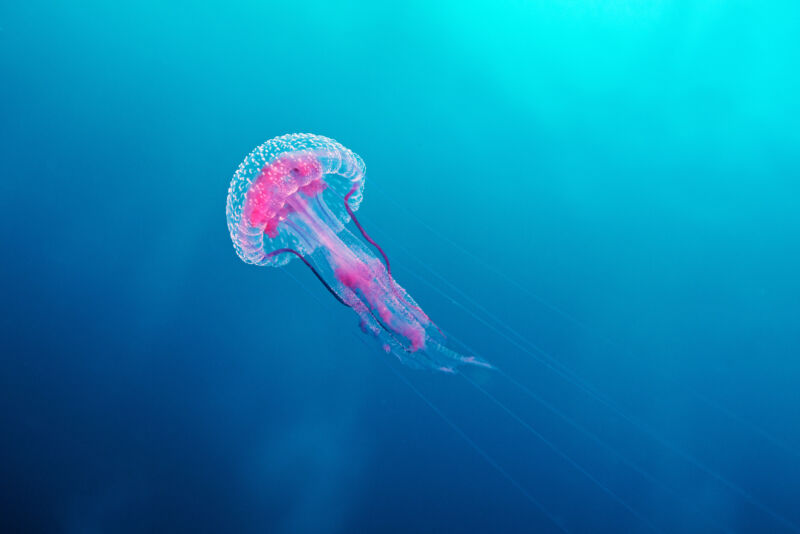The mythical Hydra may have been able to grow one of its many heads back every time it suffered a decapitation, but there are actual creatures capable of regenerating parts of their bodies bitten off by hungry predators. Jellyfish are one of them.
From salamanders to starfish to the actual hydra (a tiny hydrozoan named for the fearsome beast of legend), animals that are capable of regeneration all start the repair process by forming a blastema. This clump of proliferative cells, which are similar to stem cells, can repopulate body parts by dividing over and over again. While the cells are still undifferentiated in the beginning, they eventually form specific cell types like muscle and skin.
The process of blastema formation in some other animals has been studied, but how they form in jellyfish was still a mystery. Led by postdoctoral researcher Sosuke Fujita, the team at the University of Tokyo and Tohoku University in Japan wanted to establish a baseline for non-bilaterian regeneration by finding out how a blastema helps regrow tentacles in jellyfish. Would their blastema formation process be different from that in bilaterians?
“In particular, the current understanding of blastema formation largely relies on bilaterian models, and thus the mechanisms of blastema formation outside of bilaterians remain poorly understood,” the researchers said in a study recently published in PLOS Biology.
The regeneration process in jellyfish has been a mystery. The Japanese team finally gained new insight into this process in the jellyfish Cladonema pacificum. They found that the proliferative cells that create the blastema only appear where there is an injury—they aren’t the same as localized stem cells found at the tentacle base. But both types of cells work together to repair and regrow a severed tentacle.
An arm and a leg
Jellyfish are cnidarians, a phylum of soft-bodied invertebrates. Cnidaria also includes corals, hydras, and anemones, which all have stinging tentacles. Unlike bilaterians such as salamanders (and humans), which have bilateral symmetry (meaning a symmetrical right and left side), cnidarians have radial body symmetry, with body sections that extend out from the middle and are symmetrical all around. They have no right and left or front and back.
Because jellyfish rely on their tentacles to capture and paralyze prey, they need a lost tentacle to grow back as fast as possible. When a tentacle from Cladonema was severed with the base, or bulb, left in place, the wound at the site of the cut completely healed in as little as 24 hours. A blastema formed right after healing; the new tentacle then began growing.
The longer it grew, the more nematocytes, or stinging cells, multiplied. This suggested to Fujita and his team that regeneration occurs regardless of whether the jellyfish has recently eaten because its body automatically prioritizes regrowing a tentacle to catch food.
They just keep growing
When the blastema forms, most cell proliferation happens toward the regenerating tip of the new tentacle. Three types of differentiated cells were later found in the blastema. These are epithelial cells, which form the inner layers of the tentacle; i-cells, which help the jellyfish sense and handle food; and stinging nematocytes. Undifferentiated cells showed a tendency to turn into epithelial cells because those are the most common cells in a completely developed tentacle.
Most cells making up the blastema are not stem cells from the bulb that migrate to the tip. But there’s still something the bulb stem cells do. The team believes the cells help the newly forming tentacle grow outward from the base, adding some length while the proliferative cells elongate it from the tip. Elimination of the stem cells at the base would also delay blastema formation by a week or two.
Overall, blastema formation in jellyfish turned out to be very similar to that seen in bilaterians that are capable of regeneration. However, exactly how and where proliferative cells originate is still unclear. The researchers think it is possible that these cells are derived from already differentiated cells that dedifferentiate to form the blastema. Examples of dedifferentiated cells that form blastema have been seen in starfish and crickets.
Could humans ever be capable of regeneration? It might happen. Some experiments on animals that do not normally regenerate have successfully induced to regrow tissues. As mechanisms behind this phenomenon are better understood, human treatments using regenerative processes may someday be developed, but for now, this remains in the realm of science fiction.
PLOS Biology, 2023. DOI: 10.1371/journal.pbio.3002435



3175x175(CURRENT).thumb.jpg.b05acc060982b36f5891ba728e6d953c.jpg)
Recommended Comments
There are no comments to display.
Join the conversation
You can post now and register later. If you have an account, sign in now to post with your account.
Note: Your post will require moderator approval before it will be visible.